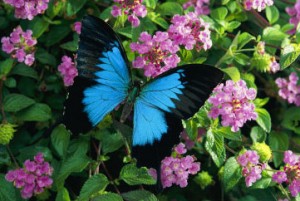
One of the great pleasures of living in Tropical North Queensland is sitting on a verandah gazing out at luxuriant rainforest. Then there is the jeweled affect of a flash of iridescent blue. Luminous in the sunshine the colour gleams against the lush greens of the rainforest like a gem on a velvet cushion. These swallowtailed butterflies dance a morse code delivered at the whim of their wings.
This is, of course, the Ulysses Butterfly (Papilio Ulysses) and there is nothing flirtatious about the dance – it is intended to confuse a predator. The better the dance the more likely they are to breed and live from two to four weeks, which is when their wings eventually tire.
Planting a garden that attracts these glorious butterflies is an investment in hours of joy. Native plants that attract them include Geijera species and Halfordia kendack. Exotic shrubs such as the Ixora are also successful. The Ulysses is attracted by red and pink and can often be seen feeding on the Ixora.
The male Ulysses has a passion for blue and in his eagerness to breed will try his luck by landing on any blue object in the hopes it is the girl of his dreams. The female Ulysses will lay her eggs on small trees, preferably over 2m high, nestled on soft regrowth leaves. Subspecies of the ulysses butterfly are also found in Papua New Guinea and the Solomon Islands.
The food of the Ulysses larvae is Melicope Elleryana, still commonly known as Euodia – the Ulysses Butterfly’s favourite food plant. It is an attractive leafy tree with clusters of small pink flowers growing straight out of the branches. Caterpillars feed singly, usually one on each plant, and rest on a pad of silk on a leaf when not feeding – which is exactly how a jewel of the forest should begin.
